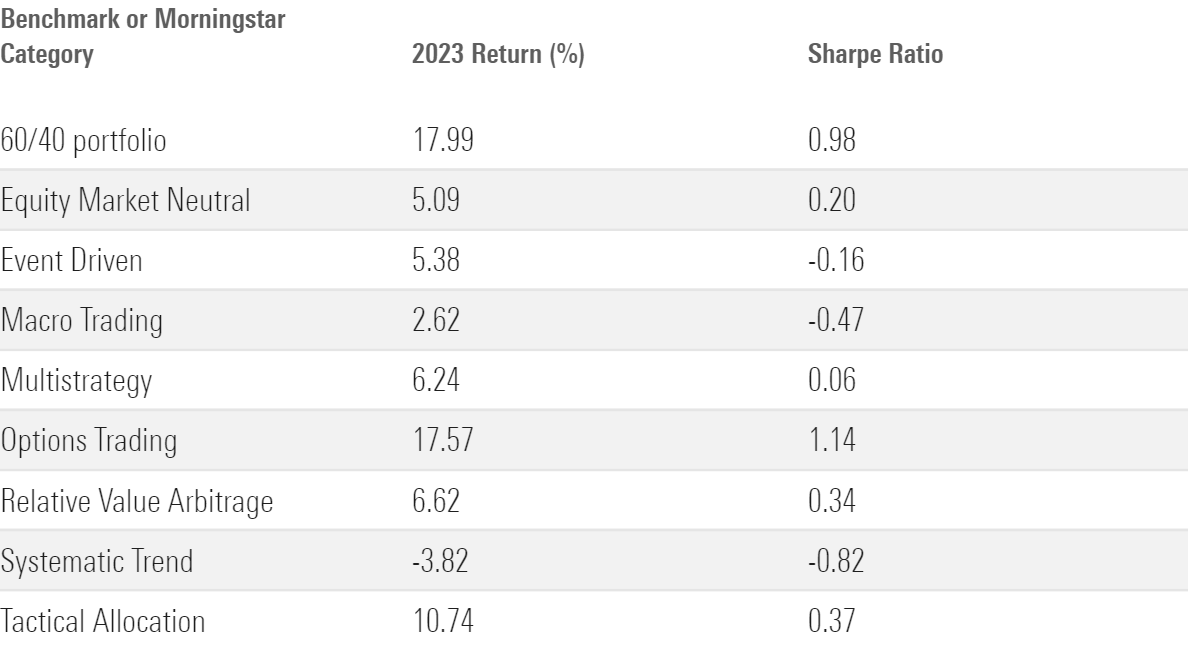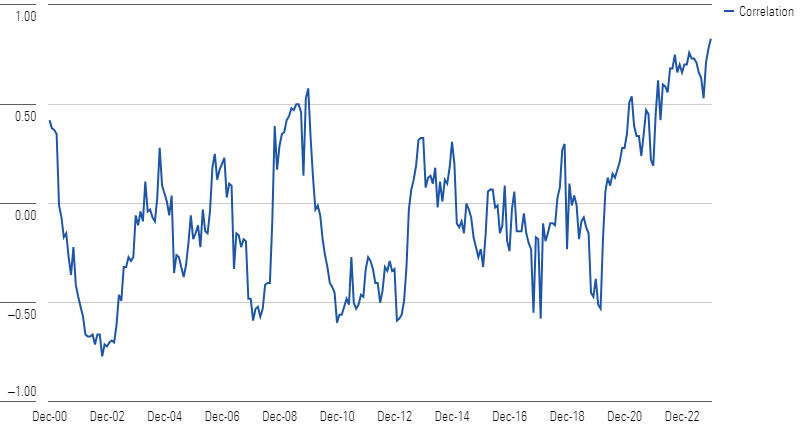Naysayers Were Wrong About the 60/40 Portfolio. Here’s Why.
After a disastrous 2022, it turned out not to be dead after all.

The dual bear market for both stocks and bonds in 2022 created the perfect storm for the 60/40 portfolio, which had been a popular asset-allocation strategy for the past couple of decades. With broad stock market benchmarks down 19% for the year and bonds down 13%, a 60/40 mix of the two suffered its worst performance since the global financial crisis in 2008.
This disappointing showing was followed by a chorus of pundits heralding the death of the 60/40 portfolio as a viable investment strategy. That didn’t happen. In fact, a standard balanced portfolio combining a 60% weighting in the Morningstar US Market Index and a 40% weighting in the Morningstar US Core Bond Index chalked up returns of 18% in 2023.
Why the Narrative Was Wrong
Heading into 2023, there were legitimate reasons to worry about the prospects for balanced portfolios. Geopolitical tensions were running high with the ongoing war in Ukraine and tense relations between the United States and China. On the heels of an abrupt economic slowdown in China, many forecasters were predicting recessions in the U.S. and Europe. On the bond side, inflation remained high, making it more likely that the Federal Reserve would continue raising rates.
Some of these events materialized, but the year turned out to be pretty decent as a whole. On the equity side, the “Magnificent Seven”—Nvidia NVDA, Tesla TSLA, Meta Platforms META, Amazon.com AMZN, Alphabet GOOGL, Microsoft MSFT, and Apple AAPL—racked up gains ranging from 50% to 240%. These double-digit gains powered broad market indexes to more than a 26% gain for the year. Bond returns weren’t bad, either: The Morningstar US Core Bond index finished the year with a 5.3% gain, as higher bond yields helped cushion losses from the Fed’s additional rate hikes during the year.
For 2023 overall, the 60/40 portfolio posted its best returns since 2019.
Calendar-Year Returns for the 60/40 Portfolio

It also fared better than many of the competing strategies often purported to be superior, such as tactical-allocation funds and alternative investments. Returns were better than all of the competing areas shown in the table below, and risk-adjusted returns outpaced all but one of them.
2023 Performance

Granted, it would be premature to declare a decisive victory for the traditional balanced portfolio. An investor who bought into the strategy at the beginning of 2022 would still have been slightly underwater (to the tune of about $200 on an initial investment of $10,000) as of Dec. 31, 2023.
Moreover, stock and bond correlations continued trending higher in 2023 after moving up significantly in 2022. When stocks and bonds are moving in tandem, combining them doesn’t offer as much of a risk-reduction benefit as it would otherwise.
Rolling 12-Month Correlations (Stocks vs. Bonds)

Future Prospects for the 60/40 Portfolio
The 60/40 portfolio could suffer additional challenges in the future. If inflation resurfaces, correlations between stocks and bonds would likely remain elevated. In our previous research, we found that stock/bond correlations often trend higher during periods of high inflation.
And even if inflation continues to moderate, conditions will likely be tougher for balanced portfolios than in the past. Even if the Fed starts cutting interest rates in 2024 (as it has indicated that it expects to do), it’s not likely to return to the zero-interest-rate policy that prevailed from January 2009 until February 2022. Without aggressive interest-rate cuts as a tailwind, correlations between stocks and bonds may not return to the low levels experienced during the zero-interest-rate policy era.
A period of more modest equity returns would also portend more moderate returns for the 60/40 portfolio. On average, the seven major asset-management firms included in Christine Benz’s annual compendium of capital market expectations (excluding GMO, which is perennially bearish) are forecasting nominal returns of about 5.5% for U.S. stocks over the next 10 years, compared with nominal returns of about 11.6% over the past 10 years.
At the same time, however, projected returns for bonds have significantly improved. The same seven firms forecast nominal returns for U.S. aggregate bonds of about 5.0%, on average, which would be a major improvement over their 1.7% average annual returns over the past 10 years.
Conclusion
There are a few lessons to draw from the 60/40 portfolio’s swift fall and partial redemption. For one, it’s not realistic to expect any portfolio strategy to excel in every market environment. As my colleague John Rekenthaler points out, it’s easy to criticize traditional balanced funds for not adapting their portfolios to changes in market conditions, but it’s far more difficult to craft something that works better. Market shifts—especially fundamental regime changes—matter, but how to position a portfolio in response is usually only obvious in retrospect.
The 60/40 portfolio strategy may not be perfect, but its simplicity and proven long-term resilience make it a much better starting point than most other approaches to portfolio construction.
Can the 60/40 Portfolio Win in 2024?
The author or authors own shares in one or more securities mentioned in this article. Find out about Morningstar’s editorial policies.

/s3.amazonaws.com/arc-authors/morningstar/360a595b-3706-41f3-862d-b9d4d069160e.jpg)
/cloudfront-us-east-1.images.arcpublishing.com/morningstar/6ZMXY4RCRNEADPDWYQVTTWALWM.jpg)
/cloudfront-us-east-1.images.arcpublishing.com/morningstar/URSWZ2VN4JCXXALUUYEFYMOBIE.png)
/cloudfront-us-east-1.images.arcpublishing.com/morningstar/CGEMAKSOGVCKBCSH32YM7X5FWI.png)
:quality(80)/s3.amazonaws.com/arc-authors/morningstar/360a595b-3706-41f3-862d-b9d4d069160e.jpg)